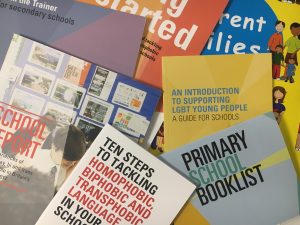In this guest blog, Sidonie Bertrand-Shelton, Head of Education Programmes at Stonewall, outlines the questions governors should be asking to make sure schools are LGBT inclusive – and why inclusivity in schools is vital.

Our work won’t be finished until every child and young person is accepted without exception, in every school, service and youth club that they encounter. Whilst is may seem that Lesbian, Gay, Bi and Trans (LGBT) inclusion is a tricky subject to manage for schools, it is needed, and hundreds of schools are already doing it well.
You will have no doubt seen the recent protests in the news by parents and carers on the ‘No Outsiders’ programme, designed to talk about different families including LGBT families and people through children’s books. This is while Relationships and Sex Education in schools is being updated for the first time since 2000, with Relationships Education becoming compulsory for all children and young people. What this shows is that parent, carer and community engagement in the equalities work of a school becomes even more important to communicate, and to do so well.
Stonewall works with over 1,300 schools in the UK on tackling homophobic, biphobic and transphobic (HBT) bullying, including faith and church schools, special schools, primary and secondary schools too. Many tackle HBT bullying and language because of their faith and school values, not in spite of them.
In 2017 we conducted research with the University of Cambridge with 3,700 lesbian, gay, bi and trans young people aged 11-19 years. The School Report (2017) found that more than half (53 per cent) said there isn’t an adult at school they can talk to about being LGBT. We also found the following:
- The majority of LGBT pupils (86 per cent) regularly hear phrases such as ‘that’s so gay’ or ‘you’re so gay’ in school
- Two in five LGBT pupils (40 per cent) are never taught anything about LGBT issues at school
- More than four in five trans young people (84 per cent) have self-harmed. For lesbian, gay and bi young people who aren’t trans, three in five (61 per cent) have self-harmed
Key to this work is that all children and young people benefit from a school that is supportive, inclusive and celebrates difference and not just those who may identify at LGBT. The Teacher’s Report (2014) found that amongst pupils who experienced homophobic bullying were boys who weren’t good at sport and girls who were. This means this bullying is often used as a tool to police gendered expectations of all children, and prevents them from achieving in school.
There is a legal responsibility for schools to be tackling HBT bullying and embedding LGBT inclusion throughout the curriculum.
- The Equality Act 2010 places a public sector duty on schools to eliminate discrimination and to encourage good relations between people who share a protected characteristic and those who don’t. This applies to the nine protected characteristics, of which LGBT identities are included (under sexual orientation and gender reassignment). This is a great tool for embracing equalities work in a way that celebrates all diversity, including faith and religion.
- In the new Ofsted Inspection Framework, schools need to be not only recording HBT incidents but including LGBT identities too. Inspectors will ask to see records of prejudice related incidents in school including homophobic, biphobic and transphobic bullying. In personal development, schools will be assessed on creating an inclusive environment that meets the needs of all pupils irrespective of gender reassignment or sexual orientation.
While there is a clear need for LGBT inclusive education and a legal responsibility for all schools as well, what questions should you be asking as governors?
- Do you receive bullying incident reports which record homophobic, biphobic and transphobic bullying incidents as well? If not, why not?
- Do the school policies use the right terminology when talking about equality for LGBT people and tackling HBT bullying and language?
- Are the administrative systems and processes inclusive of different families (including LGBT families and carers) and of different children and young people? How do you know?
- How many of the children and young people in your school identify as trans or non-binary?
- How do you hear and act on student or pupil voice from your school? What about staff voice, and your LGBT members of staff?
- Do school staff, parent and carer surveys include questions to better understand challenges on embedding LGBT-inclusion?
- Is there a staff lead for inclusion that includes LGBT in their job description?
- Do you feel confident answering a question from Ofsted on your LGBT-inclusion work in school?
Interested to find out more? There are a few ways to get involved in our network of schools:
Send one of your teachers on our CPD accredited Train the Trainer programme for schools. They will receive the skills, tools and confidence to train their colleagues on LGBT inclusion, and your school will become a Stonewall School Champion.
Once a Stonewall School Champion, you’ll be able to benchmark your school according to our Bronze, Silver and Gold award criteria and receive a certificate.
Browse through our library of free resources for more guides on LGBT inclusion across all phases
Attend our Children and Young People conference this summer, Friday 5 July in Central London. There are a limited number of discounted places are available and workshops on best practice from across our network of schools. Content includes: RSE, student voice, curriculum work and faith inclusion.
Got a question? Get in touch [email protected]